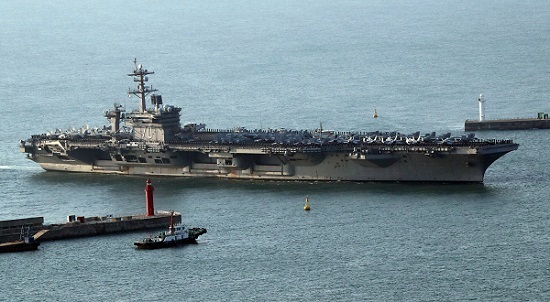Following the missile strike on a Syrian government air base, the US has sent a strike group toward the Korean Peninsula to bolster Washington’s presence in the region, as North Korea appears closer to conducting another nuclear and missile test.
The Carl Vinson Strike Group is moving toward the peninsula after stopping in Singapore. The carrier strike group was originally scheduled to sail to Australia until the US Pacific Command changed its itinerary to the Western Pacific.
 |
The USS Carl Vinson supercarrier arrives at a port in Busan, Korea on March 15. (EPA-Yonhap) |
“US Pacific Command ordered the Carl Vinson Strike Group north as a prudent measure to maintain readiness and presence in the Western Pacific,” Cmdr. David Benham, a spokesman for PACOM, said in a statement.
The deployment was mostly aimed at countering North Korea’s escalating military threat, the spokesperson added, calling the regime as “No. 1 threat in the region” for seeking “reckless, irresponsible, and destabilizing” missile and nuclear programs.
Deployed from San Diego to the Western Pacific since January, the strike group has participated in bilateral exercises with the South Korean and Japanese militaries as well as routine patrol operation in the South China Sea. The group has involved the nuclear-powered Carl Vinson aircraft and two guided-missile destroyers.
North Korea has conducted a series of ballistic missile tests and appeared to be ready for another nuclear test. The latest satellite images showed that the North‘s Punggye-ri nuclear site was crowded with a batch of vehicles and devices needed to detonate nukes and analyze its impact.
With the first summit between the US and China ending with little progress on North Korean issues, analysts expect Pyongyang to carry out another weapons test to mark a national holiday in April.
“Now that the US-China summit has ended, North Korea is likely to conduct its sixth nuclear test or launch intercontinental ballistic missiles to increase the sophistication of its weapons capability,” said Cheong Seong-chang, a senior researcher at the Sejong Institute in Seoul.
Historically, North Korea has announced advancements in its nuclear and missile program on important dates on the North Korean calendar, such as April 15, the birthday of North Korea’s founder Kim Il-sung, or the April 25 Military Foundation Day, the anniversary of the creation of a guerilla force by Kim Il-sung.
North Korea has tested nuclear devices on five previous occasions: in 2006, 2009, 2013 and twice last year. The most recent test occurred on Sept. 9, marking the founding of North Korea, and the first in 2006 came a day before the Workers’ Party of Korea’s founding day on Oct. 10.
The deployment came after US President Donald Trump concluded his first meeting with Chinese leader Xi Jinping, which was largely overshadowed by the US launch of 59 Tomahawk cruise missiles at a Syrian air base of warplanes that carried out chemical attacks on civilians Tuesday.
North Korea reacted strongly to the US attack on Syria, saying the strike was “an unforgivable act of an aggression” that vindicated the communist country’s decision to develop its own nuclear weapons program.
While President Trump pressed his counterpart Xi to play a greater role in curbing Pyongyang’s nuclear program, the historic summit offered few details about the approach other than a bilateral pledge to work together to narrow disagreements and find common ground.
The outcome has added weight to the Trump administration’s threat to act “unilaterally” against the North, including military options. During his visit to South Korea last month, US Secretary of State Rex Tillerson said “all options are on the table.”
By Yeo Jun-suk (
jasonyeo@heraldcorp.com)






![[Herald Interview] 'Trump will use tariffs as first line of defense for American manufacturing'](http://res.heraldm.com/phpwas/restmb_idxmake.php?idx=644&simg=/content/image/2024/11/26/20241126050017_0.jpg)
![[Health and care] Getting cancer young: Why cancer isn’t just an older person’s battle](http://res.heraldm.com/phpwas/restmb_idxmake.php?idx=644&simg=/content/image/2024/11/26/20241126050043_0.jpg)
